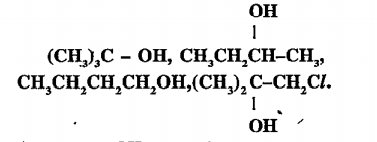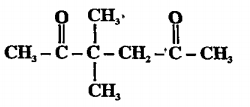Complete Solutions to QUESTION TYPE of chapter ORGANIC CHEMISTRY:SOME BASIC PRINCIPLES AND TECHNIQUES of Class 12 book with complete answers and questions
| Class 12 | CHEMISTRY |
| Chapter | ORGANIC CHEMISTRY:SOME BASIC PRINCIPLES AND TECHNIQUES |
| MBD PUBLICATION | QUESTION TYPE |
| Number Of Questions | 100 |
| Academic Year | 2023-24 |
On completing combustion, 0.246 g of an organic compound gave 0.198 g of carbon dioxide and 0.1014 g of water. Determine the percentage composition of carbon and hydrogen in the compound.
03:23View SolutionIn Dumas' method for estimation of nitrogen, 0.3 g of an organic compound gave 50mL of nitrogen collected at 300 K temperature and 715 mm pressure.
Calculate the percentage composition of nitrogen in the compound.(Aqueous tension at 300K=15 mm)05:39View SolutionDuring estimation of nitrogen present in an organic compound by Kjeldahl's method, the ammonia evolved from 0.5 g of the compound in Kjeldahl's estimation of nitrogen, neutralised 10mL of 1 M `H_2SO_4`. Find out the percentage of nitrogen in the compound.
04:19View SolutionIn carius method of estimation of halogen, 0.15 g of an organic compound gave 0.12 g of AgBr. Find out the percentage of bromine in the compound.
02:57View SolutionIn sulphur estimation, 0.157g of an organic compound gave 0.4813 g of barium sulphate. What is the percentage of sulphur in the compound?
03:31View SolutionWrite down the structural formula of 1-Bromopentan-3- one
01:51View SolutionWrite the IUPAC name of the compound
 01:38View Solution
01:38View SolutionWrite the structural formula of 1-Bromo-Methyl butane
01:28View SolutionWrite the structural formula of 4, 5, Dimethyl hex - 2- yne.
03:26View SolutionWrite the structural formula of 4-Methyl pent -2- ene
01:43View SolutionGive the structural formula of Ethyl formate.
01:26View SolutionWrite the structural formula of 3-Hydroxybutanoic acid
02:29View SolutionGive the IUPAC name of the following compound
`CH_3 -CH_2 -CH_2-CH_3`01:09View SolutionWrite the structural formula of the compound Butan-2-ol.
01:54View SolutionWrite the IUPAC name of the following compound:` CH_2 (Br) CH_2 - COOH`
02:56View SolutionWrite the structural formula of 1, 3 -butadiene
03:21View SolutionWrite the structural formula of 1-Bromo-4-Chlorobutane.
03:07View SolutionWrite the IUPAC name of the following compound ?
`CH_3` - C = C - `C_2``H_5`02:56View SolutionWrite the structural formula of 2-Butanol.
01:41View SolutionWrite the IUPAC name of `CH_3CH_2COOC_2H_5`
03:21View SolutionWrite the structural formula of pentan-3-ol .
02:02View SolutionWrite the structural formula of 2-Bromo-4-chloropentanal .
02:15View SolutionWrite the structural formula of the following compounds: pentane-2, 4- dione .
03:34View SolutionWhat is nucleophillic substitution reaction?
03:34View SolutionGive an example of elimination reaction ?
04:00View SolutionWhat is nucleophile ? Give an example of nucleophillic substitution reaction.
02:54View SolutionFormic acid is a stronger acid than acetic acid.Explain
06:37View SolutionWhich is a stronger acid acetic acid or chloroacetic acid ?
04:48View SolutionHow resonance energy is related to stability?
02:32View SolutionGive one example of nucleophilic substitution reaction.
05:29View SolutionWhich of the following is an electro-phile: `H_2O, BF_3, NH_3`?
03:21View SolutionWhat happens when ammonium cyanate is heated?
04:06View SolutionGive an example of nucleopholic addition reaction.
04:13View SolutionGive one example heterolytic fission.
02:14View SolutionDefine the term free radical.
03:44View SolutionDefine the term carbonation.
03:37View SolutionWhat are carbanions ?
02:25View SolutionWrite the order of stability of carbanions ?
04:31View SolutionWhat is inductive effect ? Write two groups each of which cause +I effect and -I effect .
08:25View SolutionWhat is resonance ? Write conditions for writing the resonating structure of the compound.
06:29View SolutionWhat are electrophiles and nucleophiles?
05:13View SolutionWhat do you mean by the reaction mechanism?
03:43View SolutionFormic acid is a stronger acid than acetic acid.Explain
06:37View SolutionCarbon-carbon bond distance in benzene is intermediate between the canbon-carbon bond distance in ethylene and ethane
06:10View SolutionMethyl amine is more bassic than ammonia.Explain.
03:48View SolutionWhat is addition reaction ? Explain its reaction mechanism with an example.
04:05View SolutionGive a detailed description of inductive effect .
05:25View SolutionWhat is resonance ? Write conditions for writing the resonating structure of the compound.
06:29View SolutionWrite notes on:
08:35View SolutionWrite notes on :
02:15View SolutionBriefly discuss quantitative analysis of organic compounds.
04:07View SolutionWrite notes on:
07:34View SolutionCarbon forms a large number of compounds because of :
03:39View SolutionThe compound `CH_3CH_2CHO` and `CH_3COCH_3` illustrate:
01:27View SolutionWhich one of the following compound is an optically active compound?
04:06View SolutionAn isomer of ethanol is:
06:59View SolutionIf the dipolemoment of toluene and nitrobenzene are 0.93 D and 3.93 D what is the dipolemoment of p-nitrotoluene ?
03:14View SolutionWhich of the following intermediate have the complete octet around carbon ?
05:44View SolutionWhat is the most common type of reactions of aromatic compounds ?
04:34View SolutionThe order of acidic strength of o, m and p-nitrophenol is
06:50View SolutionThe reaction
`(CH_3)_3C-Br overset(H_2O)rarr (CH_3)_3COH` is:02:46View SolutionThe IUPAC name of `CH_3COCH (CH_3)_2`
02:40View SolutionThe general formula of `C_nH_2nO_2` could be for open chain:
01:46View SolutionWrite the IUPAC name of the following compound:
 03:07View Solution
03:07View SolutionWrite the structural formula for the following compound: Propadiene
00:58View SolutionWrite the IUPAC name of the following compound.
 01:40View Solution
01:40View SolutionWrite the structural formula of the following compound : Ethanoic acid
01:00View SolutionWrite the IUPAC name of the following compound:
 03:16View Solution
03:16View SolutionGive the structural formula of Ethyl formate.
01:26View SolutionWhich one of the following compounds will show optical isomerism :
 05:01View Solution
05:01View SolutionWrite the structural formula of the following compound : Methanoic acid
01:29View SolutionWrite the structural formula of the following : 2-Bromo-4-chloro-pentanal
04:14View SolutionWrite the structural formula of 2-methyl-propanol-2
02:00View SolutionWrite the IUPAC name of the following : `CH_3 - CH_2 - COOC_2H_5`
02:05View SolutionWrite the structural formula of 3-pentamol.
02:12View SolutionWrite the IUPAC name of the following compound ?
`CH_3` - C = C - `C_2``H_5`02:56View SolutionWrite the structural formula of 2-Butanol.
01:41View SolutionWrite the IUPAC name of the following compound:` CH_2 (Br) CH_2 - COOH`
02:56View SolutionWrite the structural formula of 1, 3 -butadiene
03:21View SolutionWrite the IUPAC name of the following compound :
 02:28View Solution
02:28View SolutionWrite the structural formula of 1-Bromo-4-Chlorobutane.
03:07View SolutionWrite the IUPAC name of the following compound : `CH_3 - CH_2 - CH=CH_2`
02:06View SolutionWrite down the structural formula of 1-bromo-3-pentanone .
03:36View SolutionWrite the structural formula of 3-Hydroxybutanoic acid
02:29View SolutionHow many sigma and pi-bonds are present in methyl cyanide ?
02:50View SolutionGive the IUPAC name of the following : `CH_3 -CH_2 -CH=CH_2`
02:21View SolutionWrite the structural formula of the compound 1-bromo-3-pentanone .
01:49View SolutionWrite the structural formula of 4, 5, Dimethyl hex - 2- yne.
03:26View SolutionWrite the structural formula of 4-Methyl pent -2- ene
01:43View SolutionWrite the structural formula of 2-bromo-methyl butane .
01:24View SolutionArrange the following in the increasing order of C-C bond length in `C_2H_6,C_2H_4 and C_2H_2`
04:55View SolutionWhat is the isomerism between pentane, isopentane ane neo-pentane ?
03:57View SolutionThe organic compound first synthesised in laboratory is :
02:27View SolutionWhich bond is most prevalent in organic compound ?
03:08View SolutionGive the IUPAC name of `(CH_3)_3COH`
02:11View SolutionGive the IUPAC name of
 04:51View Solution
04:51View SolutionGive the graphic representation of 4-hydroxy-4-methylpentan-2-one
03:03View SolutionArrange the following in increasing order of expected enol content . `CH_3COCH_2CHO, CH_3COCH_3, CH_3CHO, CH_3COCH_2COCH_3`
05:17View SolutionWhich have high boiling points:
03:17View SolutionGive IUPAC name of :
 04:12View Solution
04:12View Solution
QUESTION TYPE questions and complete solutions for chapter ORGANIC CHEMISTRY:SOME BASIC PRINCIPLES AND TECHNIQUES of MBD CHEMISTRY (ODIA ENGLISH) of Class 12
